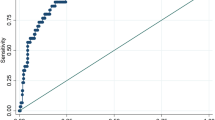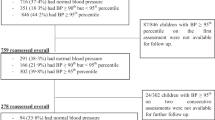Abstract
To construct reference percentiles for blood pressure (BP) by sex, age and height for the first time in Iran, we used data on 16 972 healthy children, aged 1 month to 18 years, collected during 2000–2010 in Tehran. BP in this population rose steadily with age and height following a very similar trend in both genders up to the age of 14. Systolic BP (SBP) rise was more prominent in younger ages, and after puberty (15–18 years) was greater in boys compared with girls, while the rise in diastolic BP (DBP) was slightly higher in girls. Iranian norms, compared with ‘Fourth Report on the Diagnosis, Evaluation, and Treatment of High Blood Pressure in Children and Adolescents’ (US-4th-Report) and the ‘German BP Percentiles by Age and Height for Children and Adolescents’ (KiGGS), showed a similar pattern of differences for both genders. For example, for Tehrani boys up to 6 years old whose heights were equal to 50th percentile of stature-for-age as well as length-for-age growth charts, the differences in 95th percentile for SBPs compared with the US-4th-report varied from 2–21 mm Hg while compared with KiGGS, maximum of differences was 9 mm Hg. For boys 7–15 years of age, ours were slightly higher than both. For ages of 16 and 17 years, we yielded figures lower than US-4th-report (2 mm Hg) but higher than KiGGS (3 mm Hg). Iranian 95th percentile for DBPs was lower than US-4th-report and KiGGS (1–11 mm Hg). Considering the differences with US-4th-report and KiGSS standards, the references presented in this study should rather be applied in Iranian population.
This is a preview of subscription content, access via your institution
Access options
Subscribe to this journal
Receive 12 digital issues and online access to articles
$119.00 per year
only $9.92 per issue
Buy this article
- Purchase on Springer Link
- Instant access to full article PDF
Prices may be subject to local taxes which are calculated during checkout


Similar content being viewed by others
References
Lawes CM, Hoorn SV, Rodgers A . Global burden of blood-pressure-related disease, 2001. Lancet 2008; 371 (9623): 1513–1518.
Hosseini M, Ataei N, Aghamohammadi A, Yousefifard M, Taslimi S, Ataei F . The relation of body mass index and blood pressure in Iranian children and adolescents aged 7–18 years old. Iran J Public Health 2010; 39 (4): 126.
Bao W, Threefoot SA, Srinivasan SR, Berenson GS . Essential hypertension predicted by tracking of elevated blood pressure from childhood to adulthood: the Bogalusa Heart Study. Am J Hypertens 1995; 8 (7): 657–665.
Arafat M, Mattoo TK . Measurement of blood pressure in children: recommendations and perceptions on cuff selection. Pediatrics 1999; 104 (3): e30–e30.
Horan M . Report of the second Task Force on Blood Pressure Control in Children—1987. Pediatrics 1987; 79 (1): 1–25.
Gifford R, August P, Cunningham G, Green L, Lindheimer M, McNellis D et al. Report of the national high blood pressure education program working group on high blood pressure in pregnancy. Am J Obstet Gynecol 2000; 183 (1): S1–S22.
Al Salloum AA, El Mouzan MI, Al Herbish AS, Al Omar AA, Qurashi MM . Blood pressure standards for Saudi children and adolescents. Ann Saudi Med 2009; 29 (3): 173.
Jafar TH, Islam M, Poulter N, Hatcher J, Schmid CH, Levey AS et al. Children in South Asia have higher body mass–adjusted blood pressure levels than white children in the United States: a comparative study. Circulation 2005; 111 (10): 1291–1297.
Doll S, Paccaud F, Bovet P, Burnier M, Wietlisbach V . Body mass index, abdominal adiposity and blood pressure: consistency of their association across developing and developed countries. Int J Obesity Relat Metab Disord 2002; 26 (1): 48–57.
Ashrafi M, Abdollahi M, Ahranjani B, Shabanian R . Blood pressure distribution among healthy schoolchildren aged 6-13 years in Tehran. East Mediterr Health J 2005; 11 (5-6): 968–976.
Ataei N, Aghamohammadi A, Yousefi E, Hosseini M, Nourijelyani K, Tayebi M et al. Blood pressure nomograms for school children in Iran. Pediatr Nephrol 2004; 19 (2): 164–168.
Ayatollahi S, Vakili M, Behboodian J, Zare N . Reference values for blood pressure of healthy schoolchildren in Shiraz (Southern Iran) using quantile regression. Iran Cardiovasc Res J 2010; 4 (2): 55–65.
Kelishadi R, Ardalan G, Gheiratmand R, Majdzadeh R, Delavari A, Heshmat R et al. Blood pressure and its influencing factors in a national representative sample of Iranian children and adolescents: the CASPIAN Study. Eur J Cardiovasc Prev Rehabil 2006; 13 (6): 956–963.
Hosseini M, Carpenter R, Mohammad K . Growth charts for Iran. Ann Hum Biol 1998; 25 (3): 237–247.
Hosseini M, Navidi I, Hesamifard B, Yousefifard M, Jafari N, Ranji Poorchaloo S et al. Weight, height and body mass index nomograms; early adiposity rebound in a sample of children in Tehran, Iran. Int J Prev Med 2013; 4 (12): 1414–1420.
Frese EM, Fick A, Sadowsky HS . Blood pressure measurement guidelines for physical therapists. Cardiopulm Phys Therapy J 2011; 22 (2): 5.
Ataei N, Aghamohammadi A, Ziaee V, Hosseini M, Dehsara F, Rezanejad A . Prevalence of hypertension in junior and senior high school children in Iran. Iran J Pediatr 2007; 17 (Suppl 2): 237–242.
Cole TJ, Green PJ . Smoothing reference centile curves: the LMS method and penalized likelihood. Stat Med 1992; 11 (10): 1305–1319.
Stanojevic S, Wade A, Stocks J, Hankinson J, Coates AL, Pan H et al. Reference ranges for spirometry across all ages: a new approach. Am J Resp Crit Care Med 2008; 177 (3): 253.
Cole T, Stanojevic S, Stocks J, Coates A, Hankinson J, Wade A . Age‐and size‐related reference ranges: A case study of spirometry through childhood and adulthood. Stat Med 2009; 28 (5): 880–898.
Rigby R, Stasinopoulos D . Generalized additive models for location, scale and shape. J R Stat Soc Series C (Applied Statistics) 2005; 54 (3): 507–554.
Neuhauser HK, Thamm M, Ellert U, Hense HW, Rosario AS . Blood pressure percentiles by age and height from nonoverweight children and adolescents in Germany. Pediatrics 2011; 127 (4): e978–e988.
Hammond IW, Urbina EM, Wattigney WA, Bao W, Steinmann WC, Berenson GS . Comparison of fourth and fifth Korotkoff diastolic blood pressures in 5 to 30 year old individuals* The Bogalusa heart study. Am J Hypertens 1995; 8 (11): 1083–1089.
Liang L, Mi J, Zhang M, Wang Y, Wang T . [Study on the impact of the choice of diastolic Korotkoff phase in childhood on prediction to adult hypertension]. Zhonghua Liu Xing Bing Xue Za Zhi 2008; 29 (2): 110–115.
Muntner P, He J, Cutler JA, Wildman RP, Whelton PK . Trends in blood pressure among children and adolescents. JAMA 2004; 291 (17): 2107–2113.
Mi J, Wang T-y, Meng L-h, Zhu G-j, Han S-m, Zhong Y et al. Development of blood pressure reference standards for Chinese children. Chin J Evid Based Pediatr 2010; 5 (1): 4–14.
Rosner B, Cook N, Portman R, Daniels S, Falkner B . Determination of blood pressure percentiles in normal-weight children: some methodological issues. Am J Epidemiol 2008; 167 (6): 653–666.
TK-B Colin Sumpter, Clifford David, Cronberg Alexandra, Vekinis Dalina . Camden Profile Public Health Intelligence Childhood Overweight and Obesity. Camden Clinical Commissioning Group 2014: Camden, NJ, USA, 2014.
Munkhaugen J, Lydersen S, Widerøe T-E, Hallan S . Blood pressure reference values in adolescents: methodological aspects and suggestions for Northern Europe tables based on the Nord-Trondelag Health Study II. J Hypertens 2008; 26 (10): 1912–1918.
Jackson LV, Thalange NK, Cole TJ . Blood pressure centiles for Great Britain. Arch Dis Childhood 2007; 92 (4): 298–303.
Sung RY, Choi KC, So H-K, Nelson EA, Li AM, Kwok CW et al. Oscillometrically measured blood pressure in Hong Kong Chinese children and associations with anthropometric parameters. J Hypertens 2008; 26 (4): 678–684.
Alsanjari O, de Lusignan S, van Vlymen J, Gallagher H, Millett C, Harris K et al. Trends and transient change in end‐digit preference in blood pressure recording: studies of sequential and longitudinal collected primary care data. Int J Clin Pract 2012; 66 (1): 37–43.
Wen SW, Kramer MS, Hoey J, Hanley JA, Usher RH . Terminal digit preference, random error, and bias in routine clinical measurement of blood pressure. J Clin Epidemiol 1993; 46 (10): 1187–1193.
Hosseini-Esfahani F, Mirmiran P, Ghanbarian A, Azizi F . Trends in risk factors for cardiovascular disease among Iranian adolescents: the Tehran Lipid and Glucose Study, 1999-2008. J Epidemiol 2010; 21 (5): 319–328.
Hosseini M, Taslimi S, Dinarvand P, Jones M, Mohammad K . Trends in weights, heights, BMI and comparison of their differences in urban and rural areas for Iranian children and adolescents 2–18‐year‐old between 1990–1991 and 1999. Child Care Health Dev 2010; 36 (6): 858–867.
Acknowledgements
We thank all the children, adolescents and their families who cooperated in the three surveys and all the colleagues who helped in measurements. This present study is the result of a research project enacted by the Pediatric Kidney Disease Research Center (Grant Number 92-03-184-24284), the Children’s Hospital Medical Center, Faculty of Medicine, Tehran University of Medical Sciences, Tehran, Iran. We would like to thank Dr Mahmoud Yousefifard and Dr Masoud Baikpour and Mr. Hadi Asady for their invaluable help. In addition, we are especially grateful for the help of Dr ME Jones at Section of Epidemiology, The Institute of Cancer Research, Sutton, UK.
Author information
Authors and Affiliations
Corresponding author
Ethics declarations
Competing interests
The authors declare no conflict of interest.
Rights and permissions
About this article
Cite this article
Ataei, N., Hosseini, M., Fayaz, M. et al. Blood pressure percentiles by age and height for children and adolescents in Tehran, Iran. J Hum Hypertens 30, 268–277 (2016). https://doi.org/10.1038/jhh.2015.52
Received:
Revised:
Accepted:
Published:
Issue Date:
DOI: https://doi.org/10.1038/jhh.2015.52
This article is cited by
-
Genome-wide association study on blood pressure traits in the Iranian population suggests ZBED9 as a new locus for hypertension
Scientific Reports (2021)
-
Epidemiological studies in hypertension: more relevant than ever
Journal of Human Hypertension (2016)



